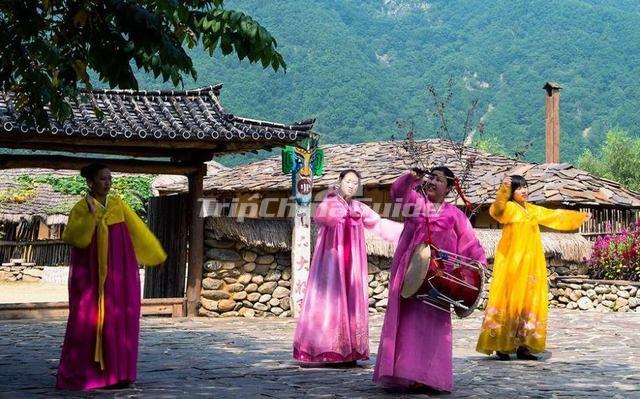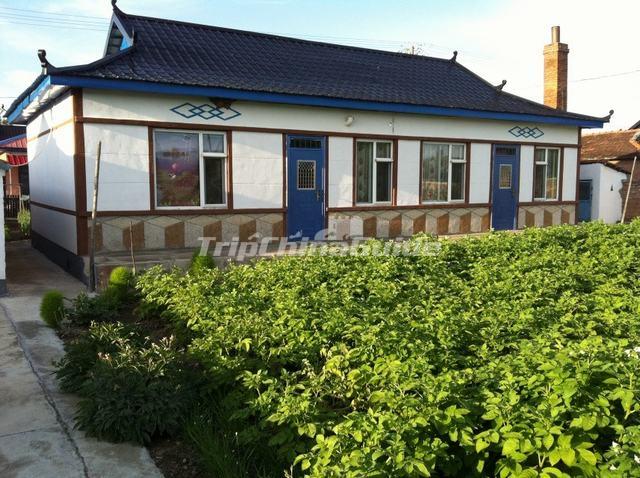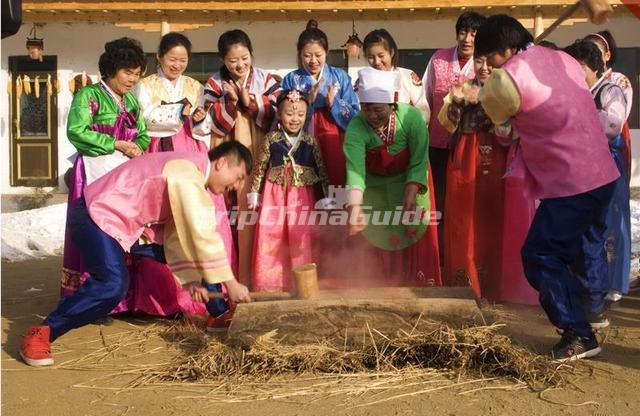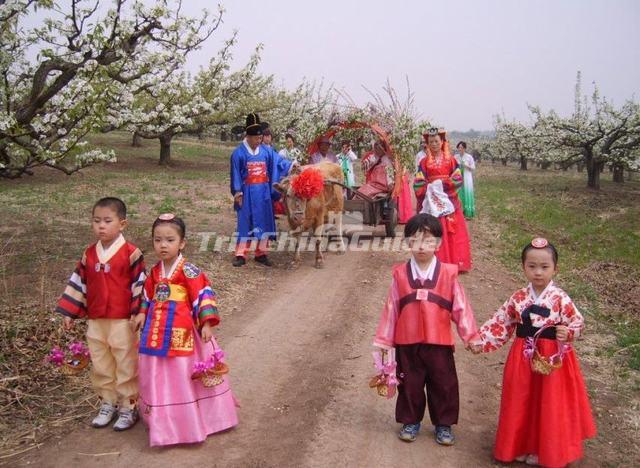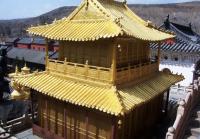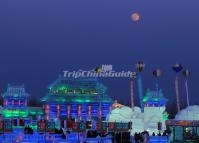Korean Ethnic Group
The Korean people are one of the 56 ethnic groups officially recognized by the People's Republic of China. Korean people is a nationality with glorious revolutionary tradition, during the Anti-Japanese War and Liberation War, the Koreans have made outstanding contributions for fighting the Japanese aggressors and the liberation of the motherland.
Population
1,830,929 (2010)Main Areas Inhabited by Korean
The largest concentration of Koreans is in the Yanbian Korean Autonomous Prefecture in eastern Jilin Province. Under its jurisdiction are the cities of Yanji and Tumen, and the counties of Yanji, Helong, Antu, Huichun, Wangqing and Dunhua, covering a total area of 41,500 sq. km. Another community of Koreans lives in the Changbai Korean Autonomous County in southeastern Jilin.
Terrain, Traffic and Resources
The Yanbian Korean Autonomous Prefecture is a beautiful, majestic land of high mountains and deep valleys. The land rises to 2,744 meters above sea level to the highest peak of the Changbai Mountains -- White Head Summit. This is an extinct volcano, from the crater lake of which spring the Yalu and Tumen Rivers, flowing south and north respectively, and forming the boundary with the Democratic People's Republic of Korea to the east. The area is accessible nowadays by both road and rail, except for the mountain-locked Hunchun District. The prefecture has 1,600 km of railways and 3,700 km of highways and branch roads. Yanbian is also blessed with agricultural riches and is a major tobacco producer. It is famous for apples and pears, which have been exported since 1955.
The Changbai Korean Autonomous County is one of China's major sources of timber and forest products, including ginseng, marten pelts and deer antlers. It is also a habitat for many wild animals, including tigers. Copper, lead, zinc and gold have been mined here since the Qing Dynasty (1644-1911), and the area also has deposits of iron, antimony, phosphorus, graphite, quartz, limestone and oil shale.
Origin
The ancestors of the Korean ethnic group migrated from the Korean peninsula from about the late 17th century, mostly peasants fleeing from their oppressive feudal landlords. Especially following a severe famine in the northern part of Korea in 1869, they settled down in large numbers in what is now the Yanbian area. Another wave of migration took place in the early years of this century when Japan annexed Korea and drove many peasants off the land. The Japanese seizure of the Manchurian provinces further served to drive landless Koreans to settle in Northeast China.
Language
The Koreans have their own spoken and written language, which is thought to belong to the Altaic family. Their alphabet is a simple, ingenious one, and the Koreans are very proud of it.
Clothing
The traditional Korean dress is white, a symbol of simplicity and serenity. Men wear baggy trousers fastened at the ankles and a jacket which fastens on the right; sometimes they wear a high-crowned black horsehair hat. Women wear voluminous skirts and a tight jacket which reaches just below the armpits.
Food
Their cuisine is very spicy and includes kimchi (pickled vegetables), cold noodles, sticky rice cakes and dog meat.
Building
Yanbian is fairly evenly populated, with villages set a few miles apart from each other and ranging in size from about a dozen households to several scores. The houses are built of wood with low-eaved tile or thatched roofs. They are heated by flues running under a raised platform in the main rooms, which serves as a bed and also a place to sit on. Shoes are removed before entering the house.
Culture and Art
This ethnic minority has its own rich literary heritage. Folk literature has a variety of forms such as folk songs, legends, folk story and folk drama, etc. The Koreans are very fond of music. They sometimes sing and dance to the accompaniment of drums and flutes in the fields or on construction sites. The traditional folk musical instruments are Long Drum, Xì Bì Lì, Kayagum, etc.
Religion
Korean people don't have the unity of the national religion. Because under the influence of the international, the Korean people who belief in Christianity have increased.
Festivals
Traditional festivals are celebrated heartily, especially the Lunar New Year, and the Mid-Autumn Festival. Other occasions for merriment are the 100th day after a baby's birth and a person's 60th birthday.
Marriage and Family
In the old days, men labored in the fields while women worked around the house. The eldest son became the head of the family upon the death or incapacitation of the father. Monogamy was practiced but early marriage and adoption of child brides and boys to carry on the family tree were common.
Funeral
Korean people bury the dead in the ground, people scattered in the town are practice cremation. Relatives are not allowed to wash face, cut hair; also they can't eat cooked rice and must be wear mourning after the death of the old man.
Cultural Progress
Ⅰ. Language Progress
Culturally, the Koreans suffered worst of all the peoples enslaved by the Japanese; they were forced to speak the Japanese language and adopt Japanese surnames. But Japan's attempt to destroy Korean culture came to naught in 1945, and there was a resurgence of cultural awareness among the Koreans.
Newspapers in the Korean language sprang up, including the Jilin Daily (later renamed the Yanbian Daily), Heilongjiang Daily and the Liaoning Daily. In 1947, the Yanbian Korean Publishing House was founded in Yanji, and the Yanbian People's Radio went on the air. Special Korean programs are also aired by the Central People's Broadcasting Station and the Heilongjiang People's Broadcasting Station.
Ⅱ. Education Progress
Particular attention was paid to education. In 1949, the Yanbian University was founded in Yanji. Other institutions of higher learning established during the early post-liberation period include the Yanbian Medical Institute, the Yanbian Amateur Agricultural University and a teachers college. Universal secondary education was realized as far back as 1958.
As a result, there are now large numbers of people of Korean origin at all levels of leadership in many areas of China, and at renowned educational institutions in China's major cities. The Yanbian area is noted also for its culture and art troupes and cultural organizations. At the prefectural level, these include the United Association of Yanbian Culture and Art Workers and the Yanbian Branch of the Chinese Writers Association. The Yanbian song and dance, modern drama and theatrical companies are famous all over the country, and many Korean artists study at advanced institutes in other parts of China.
Ⅲ. Medical Progress
The Korean ethnic minority has set up an efficient network of health care centers and hospitals, including the Yanbian Hospital, a tuberculosis treatment center, an anti-epidemic hospital and a psychiatric sanatorium. The Yanbian Korean Autonomous Prefecture boasts high standards of maternity, childcare and family planning, as well as an enviable record in the fight against endemic diseases.
Taboos
According to Korean's tradition, two young people who are closely related or who share the same surname are not allowed to get married. In Korean families, men are responsible for taking care of matters outside while women's duties revolve around caring for inside their homes.
Korean people respect the old and mark every Aug 15th as the day of the older persons. On that day, younger people are forbidden to drink or smoke in front of the elders. They are also expected to walk behind their elders and to give way and greet elders when meeting them. In the Korean family, the elder son is expected to support his parents forever. Anyone who is not dutiful to their parents will be looked down in their community.







